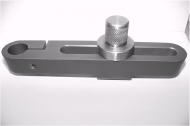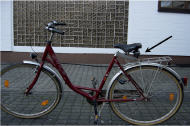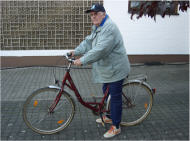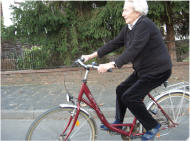Rosemarie Cooper, MPT, ATP, Rory A. Cooper , PhD, Jeremy Puhlman, B.S, Jens Groll
University of Pittsburgh , Human Engineering Research Laboratories
Pittsburgh , Pennsylvania 15213
ABSTRACT
The objective of this project was to design, fabricate, and test, a bicycle seat adapter to adjust the position of a bicycle seat to accommodate to the rider’s need for comfort, safety and stability. For example senior riders after total knee and/or hip replacement may find it difficult to return to their cycling activities as they experience limitations in joint range of motion. On conventional bicycles the only option to accommodate to lower extremity range of motion limitations is to raise the seat; which in turn compromises stability, as the rider’s feet may not be able to touch the ground when trying to stay seated on the bike.
The seat adapter is an innovative way to retrofit the seat position of a standard bicycle in order to accommodate limited knee range of motion during outdoor cycling activities, yet allow the rider to remain seated while both feet stand on the ground for increased balance during starts and stops. This adapter can be attached to an existing seat post of a conventional bicycle, and it uses a rectangular design with a hollow groove that allows horizontal adjustability of the bicycle seat without affecting the overall seat height.
The catalyst for this case study, involved the 1 st author’s parents, who after total knee and hip replacements, wished to resume riding their bicycles for recreational enjoyment and physical activity. Limited range of motion, combined with concerns of falling during stops, prevented them from resuming this activity. They were provided with the opportunity to test the retrofit adapter on their existing bicycles and both were able to resume their daily cycling activities. Even thought the seat adapter was designed with specific uses in mind, it is however, universal enough to allow a simple and easy retrofit to any bicycle frame seat post.
KEYWORDS
Seniors, Biking, Retrofit Bicycle Seat Adapter
BACKGROUND
 |
|---|
The number of people older than 50 is expected to double between 1990 and 2020.(1) Advances in medicine have made it possible for more people to live longer, but they also want to live healthier. Retired Americans make up an increasing percentage of the population, and senior Americans expect to be active in retirement. They have little control over their genetics or environmental factors, but the things they can control – diet and exercise—affect their longevity and quality of life. (1) Increasing fitness by participating in a regular exercise program can reduce the effects of aging that lead to functional declines and poor health. Literature reveals that increasing fitness by participating in a regular exercise program can reduce the effects of aging that lead to functional declines and poor health. (2) Regular exercise can improve the physical and mental heath of the elderly, even though it cannot halt the anatomic changes that occur with aging (3).
 |
|---|
Biking for seniors offers many benefits, including freedom to ride wherever there is a road or trial. It is an aerobic activity with low impact on the joints. It is also a recreational activity that crosses over multiple generations, and allows the senior citizen to remain active within the family and community recreational activities.
Seniors have access to a few bicycles that are designed with their needs in mind. The bike options range from “Cruiser”- bikes, over “Recumbent” bike, to “Tri-cycles”. The Cruiser are a good choice for senior riders because of their stability and the comfort of their upright position, yet still being positioned closer to the ground. The recumbent bike-this is a bicycle that allows the rider to sit in a position lower to the ground and with less pressure on the joints and less strain on the neck during the ride. Another option is the tri-cycle that provides increased stability and the rider does not have to worry about balance. All of these options are more expensive than stabdard bicycles and may be stigmatizing.
RESEARCH QUESTION
 |
|---|
Since the purchase of a new bicycle was ruled out, and the riders’ ultimate goal was to be able to ride their own bicycles again, the following criteria had to be part of the design:
- The adapter needed to be attached to the existing seat post of a conventional bicycle to allow horizontal adjustability of the bicycle seat without affecting the overall seat height.
- Installation and removal of the adapter needed to be intuitive, if in the future the rider wished to return to pre-exiting seat position.
METHOD
 |
|---|
The design required precise geometry to act as a medium between the bike seat post and the seat itself. The Bicycle Seat Adapter was designed using CAD software; SolidWorks. Once the design was finalized, FeatureCam software was used to write the numerical code for fabrication. This design consisted of three parts: the seat extender, bottom slider, and the seat insert. The seat extender was made out of aluminum. The Wire EDM (Electro Static Discharge Machining) was used to cut this piece from 6061T6 aluminum bar stock. After the Wire EDM was finished, the seat extender was clamped in a milling machine for secondary machining. This part was to clamp to the bike seat post and contain a slot for 4” of adjustability forward and backward. The bottom slider was also made of aluminum and fabricated on the Wire EDM with the mill performing secondary machining. The function of this part is to secure the seat insert in the desired position. The seat insert was made out of stainless steel to avoid rusting. Anodizing was done to harden the aluminium and prevent scratching. It was machined on the lathe with secondary machining on the mill. The seat insert connected to the bottom slider and allows the bike seat to be fastened to its’ post.
RESULTS
 |
|---|
The adapter was attached to the existing seat post of the riders’ conventional bicycles. Attachment was intuitive and performed with minimal assistance by both riders. The bicycle seat was mounted onto the seat receiver and horizontal adjusted to meet the riders positioning and cycling comfort. Within a very short period, the next day, both riders were comfortable on their bicycles and have returned to their daily cycling activities.
DISCUSSION
 |
|---|
Realizing that the focus of this project was on the 1 st author’s parents, they are nevertheless two representatives of a growing aging population that still enjoys physical activities and would like to remain physically active even when experiencing limitations as a natural part of aging.
Even though the seat adapter was designed with specific users in mind, it is however, universal enough to allow a simple and easy retrofit to any bicycle frame seat post. The retrofit bicycle seat adapter is a low cost option that can be tried on a bicycle without buying an entirely new bicycle. It allows the rider to continue using a familiar bicycle by adding adjustability and still maintaining the look. All controls and functions remain unchanged.
References:
- Mees, Patricia, Key to the fountain of Youth, Physically active for life, The Physician and Sportmedicine – Vol. 31-No.12-December 2003
- Brennan, Fred H, Exercise Prescriptions for Active Seniors, A Team Approach for Maximizing Adherence, The Physician and Sportmedicine – Vol. 30-No.2-February 2002
- Healy, William L., Athletic Activity after Joint replacement , American Journal of Sports Medicine, May 2001
ACKNOWLEDGEMENTS
This study was partially supported by the Veterans Affairs Center of Excellence on Wheelchairs and Related Technology (Award number F2181C)
Author Contact Information:
Rosemarie Cooper, MPT,ATP
7180 Highland Drive, Building 4, 2 nd Floor
East Wing 151R-1
Pittsburgh, PA 15218
Office Phone (412) 365-4850
EMAIL: cooperrm@pitt.edu